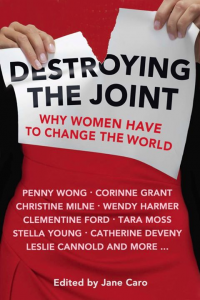lip lit: destroying the joint
Several F-words spring to mind to describe the writers anthologised in Destroying the Joint. Fabulous. Fiery. Funny. Feisty. Fierce. And, perhaps most importantly: Feminist.
The pieces contained in this book originated as impassioned responses to Alan Jones’ awful and offensive remark in August 2012 that ‘women are destroying the joint’. Notable Australian women were asked to respond specifically to Jones, and generally to Australia’s rampant culture of sexism and misogyny. The resulting works have been collected by editor Jane Caro in this anthology, subtitled Why women have to change the world. It’s a motley collection of essay, polemic, memoir and fiction, from a diverse and brilliant range of contributors.
There is much food for feminist thought here, with contributions from women who span the arenas of media, politics, academia, comedy, activism, and education. It’s an impressive array of thinkers and agitators, and Destroying the Joint’s diversity of voices is one of its greatest strengths.
Of particular note is the strong representation of ideas and opinions from young women. Dannielle Miller writes ‘An Unapologetic Love Letter to Teen Girls’, in which she rhapsodises on the ‘loveableness, but also the strength and resilience, of girls’. Michelle Law shares the story of her birth, and reveals how it eventually brought about her feminist coming of age. Steph Bowe and Lily Edelstein, two immensely talented teenage writers, write frankly and with great humour about the reality of their own experiences. These writers offer a realistic snapshot of contemporary girlhood, but resist the urge to dramatise or romanticise adolescence.
Novelist Melissa Lucashenko contributes an incredibly moving paean to her remarkable great-grandmother, Christina. As an Indigenous woman in early twentieth-century Australia, Christina was doubly discriminated against. She achieved the seemingly impossible when she not only successfully defended herself against her rapist by shooting him, but also subsequently had him charged and jailed for the crime.
Some forms are more successful than others – Yvette Vignando’s experimental epistolary piece in tweets is jarring, the brevity of 140 characters limiting the depth of expression. Works of fiction are a potentially problematic inclusion in a collection so grounded in present reality, but beautiful short stories by Krissy Kneen (‘The University and the Beast: A Fairy Tale’) and Susan Johnson (‘Outside Manners’) are pitch perfect. Their thematic and narrative relevance to the Destroy the Joint movement is obvious but not heavy-handed, and they function equally well as works of fiction independent of the book.
The concerns raised in Destroying the Joint confirm just how wide-reaching and ingrained gender inequality is in Australia (and around the world). Stella Young – on the challenges faced by women with disabilities – and Carmen Lawrence – on environmental feminism – explore aspects of feminism which are often overshadowed or denied. Emily Maguire’s description of the courage displayed by overseas joint-destroyers, many of them from repressive societies, provides perspective. Some of the pieces contain a palpable undertone of despair, but this is always matched by a ferocious determination to expose and combat misogyny.
Unfortunately, the brevity of the pieces can be to their detriment. Frequently, initial paragraphs are taken up with aggrieved outrage at Alan Jones, and followed by assertions that the times they are a-changin’. Jones’ comments were outrageous, and societal change is both desirable and ongoing. Too often, however, writers repeat these same sentiments and fail to develop a personal interpretation of their significance. In such instances, the writing feels familiar but abrupt. Some of these pieces would benefit from being expanded further, allowing the writers to strengthen their arguments and refine their focus.
Destroying the Joint is an occasionally uneven collection, and the speed with which the pieces were commissioned and collated is palpable. But it this very sense of urgency and immediacy which propels the book. As the writers suggest, something is shifting in Australian society. Awareness and condemnation of sexism and misogyny is intensifying. Where they have been silenced and ignored, women are pushing against oppression and refusing to be cowed. Destroying the Joint is a reclamation of voice and a proclamation of power on behalf of all women, whether they destroy the joint or rebuild it anew.
Destroying the Joint: Why women have to change the world by Jane Caro (ed.) is published by University of Queensland Press.
Veronica Sullivan is a writer, bookseller and masters student from Melbourne. She blogs here and tweets here.


